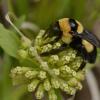
Hylaeus mauiensis is a small bee endemic to the island of Maui in Hawaii. It is a member of the dumetorum species group, distinguished by the lack of a yellow mark on the clypeus. The species is known only from two specimens collected in the 1890s, one of which is lost, and may be extinct.
Males
Black, face with two yellow paraocular marks; otherwise unmarked. Propodeum long, mostly smooth.
Females
Black, with two narrow yellow paraocular marks. Pronotum marked with yellow. Hylaeus mauiensis is a member of the dumetorum species group. It is the most melanic of the group, the only one lacking yellow on the clypeus. The female specimen has been lost, so the association is uncertain; it is unusual for the female to have more yellow than the male.
Taxonomic Status
Hylaeus mauiensis was described as Nesoprosopis mauiensis by Perkins (1899). Nesoprosopis was reduced to a subgenus of Hylaeus by Meade-Waldo (1923). The most recent taxonomic treatment was Daly and Magnacca (2003).
Hylaeus mauiensis inhabits montane wet forest and probably nests in the wood like related species. Nothing more is known about it.
Hylaeus mauiensis has been collected only once, from the moutains of East Maui.
Xerces Red List Status: Critically Imperiled (Possibly Extinct)
Other Rankings:
Canada – Species at Risk Act: N/A
Canada – provincial status: N/A
Mexico: N/A
USA – Endangered Species Act: None
USA – state status: None
NatureServe: GNR
IUCN Red List: N/A
This species is extremely rare, known from only two specimens collected over 100 years ago. However, the rain forests of East Maui are difficult to access and collect in and have not been searched for bees recently. Therefore, it is likely that H. mauiensis persists, though it is probably still rare. U.S. Federal listings of rare and endangered species classed H. mauiensis as a “Category 3A” Candidate Species, considered “probably extinct”. It currently has no status as a “Species of Concern” at the federal or state level.
The rarity of H. mauiensis and lack of knowledge about its requirements make it difficult to assess threats. Habitat degradation due to feral pigs and invasive plants is probably the most serious threat.
The top conservation need is to document the continued existence of the species. The areas where it is likely to be found are protected under the jurisdiction of the Nature Conservancy, State of Hawaii, and National Park Service. Research is needed in order to locate extant populations and determine reasons for rarity.
Daly, H. V., and K. N. Magnacca. 2003. Insects of Hawaii, Vol. 17: Hawaiian Hylaeus (Nesoprosopis) Bees (Hymenoptera: Apoidea). University of Hawaii Press, Honolulu. 234 pp.
Meade-Waldo, G. 1923. Hymenoptera, fam. Apidae, subfam. Prosopidae, fasc. 181. Pp. 1-45 in P. Wytsman (ed.), Genera Insectorum. L. Desmet-Verteneuil, Brussels.
Perkins, R. C. L. 1899. Hymenoptera, Aculeata. Pp. 1-115 in D. Sharp (ed.), Fauna Hawaiiensis, Vol. 1. Cambridge University Press, Cambridge, United Kingdom.
Citation
Magnacca, K. N. 2005. Species Profile: Hylaeus mauiensis. In Shepherd, M. D., D. M. Vaughan, and S. H. Black (Eds). Red List of Pollinator Insects of North America. CD-ROM Version 1 (May 2005). Portland, OR: The Xerces Society for Invertebrate Conservation.
Profile prepared by Karl Magnacca, USGS-BRD, Kilauea Field Station





